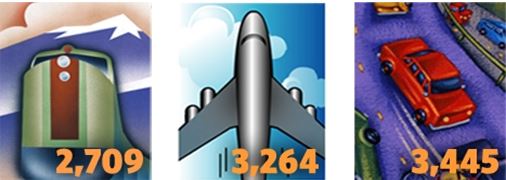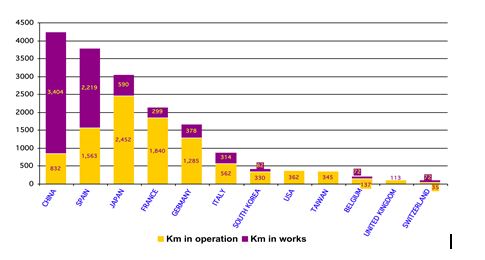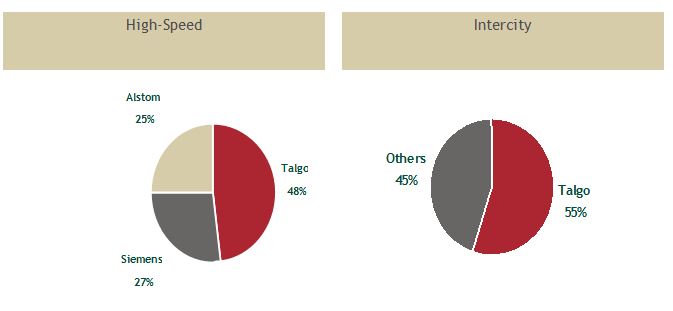Government and Rail Agencies
Talgo intends to provide you with solutions for your state of the art High Speed trains and outstanding maintenance service needs.
What is Intercity Rail?
Customary Definition: Intercity Rail is a family of passenger rail technologies ranging from modern tilting coaches on upgraded existing rail tracks to highly advanced “bullet” train systems on new rights of way, designed primarily for intercity business and leisure travel.
Practical Definition: A long and neglected transportation mode that can help solve congestion by cost-effectively moving people from point A to point B.
What Intercity is not
- Commuter Rail – service between a city center and an outer city or suburb. Used for people who travel on a daily basis.
- Light Rail (subway, monorail) – these are vital transportation links in and around metropolitan areas.
- Long Distance Rail – These are vital transportation links between regional corridors.
Intercity Rail is…
The vital transportation link between metropolitan areas within a regional corridor.
Why Intercity Rail?
1. Gridlock
The average driver spends the equivalent of nearly one full work week each year stuck in traffic. Congestion costs Americans billions in wasted fuel and lost time. Today, the average distance cars and trucks are driven equals a journey more than a half way around the earth.
(In 1998, cars and light trucks were driven 2.4 trillion miles, or approximately 1/10th of the distance to the nearest star outside the solar system.)
2. Greater Efficiency
We’re in love with our cars. We swear by the freedom and mobility they give us in our daily lives. But these benefits come with a cost.
- Transportation accounts for 2/3 of all domestic oil consumption
- In 1994, Automobiles used 39% of all transportation energy
- Light trucks (mini-vans SUVs & pickups) used 20% of transportation energy
- Americans spend approximately $100k per minute to buy foreign oil for cars and trucks
Nobody wants to replace cars and highways. But we can lessen the energy burden while increasing capacity by providing a rail alternative to short-to-medium range high-density locales.
3. Environmental Benefit
Our new generation of trainsets, the Talgo 250 and Talgo 350 are electrically powered thus there is significant reduced need for petroleum.
What does it take to move one person one mile?
Rail is 17% more efficient than domestic airline travel
Rail is 21% more efficient than automobile travel
All measures are in British Thermal Units of energy per passenger mile
All data as of 2005; U.S. DoE, “Transportation Energy Data Book,” 26th Edition
4. Improved Intercity Mobility
- Rail is as fast as air travel on a door-to-door basis (100-400 mile corridor)
- More affordable, convenient and comfortable than air travel
- Virtually weatherproof
- More accessible to senior citizens, persons with disabilities and millions of Americans that do not have cars.
5. Part of the Transportation Solution
All of the world’s industrialized nations have evolved and embraced balance in their efforts to transport their citizens – through air, road and rail. For too long, the U.S. has relied upon two of those forms of transport. As gridlock spreads and costs mount, the benefits of revitalizing the third mode, rail, are becoming clear.
- Augments other travel modes
- Supports commuter and light rail
- Complements services to major airportsjlajsdkl
Length of High Speed Lines in the world -In Operation + In Works Spain is 2nd
6. Economic Revival
- New Jobs and Economic Growth
- Creates temporary jobs during construction, permanent jobs thereafter
- Downtown revitalization is promoted
- Promotes tourism and intra-regional transfer of goods
- Sales Gain: Businesses realized a gain in sales 3 times the investment capital in trainset (e.g. : a $10M investment results in $30M in sales)
- Highways push people away from cities; Intercity rail pulls people, jobs and businesses back to urban centers
- Counters suburban sprawl
- Tran stations encourage further economic development
- Overall impact: Creates savings to business operations and increases overall efficiency of the economy, positively affecting business sales and household incomes.
7. People Want it
- 68% of Americans agree with spending public funds to build or improve rail systems to reduce traffic congestion.
- 69% of Americans favor, and 41% strongly favor, creating high speed train service to serve their communities and provide connections between major population areas
- 87% of Americans believe the US Government currently possesses the resources to build high speed rail system; 66% believe traffic congestion will not be eased by building more roads
*source 200 U.S. Conference of Mayors
8. What if my agency does not have the money up front?
High speed rail is the solution to many transportation problems: It reduces congestion on roads and at airports, is cost effective and convenient, improves mobility and has environmental benefits. But the implementation of a high speed project requires significant up front investments that require sizeable multi-year budgetary commitments. Many times the public agencies do not have the ability to meet the financial requirements needed to undertake a brand new high speed corridor. Other times, the political will is not clear and therefore the straight development of a new high speed project is not possible. In these cases, the alternative is the design of a plan with an incremental approach that consists in reaching partnership agreements with stakeholders to reach the ultimate goal of better and faster intercity rail service, but staging the implementation process according to the availability of funds and political circumstances.
This alternative approach is particularly applicable in the USA, where the passenger rail development was abandoned in the 50’s, and where the freight rail companies acquired the tracks and right of ways. The freight rail companies’ business in not to move people but goods and many times a passenger train is seen as a nuisance that is allowed only because a law force them to do so. In an incremental approach plan, the owner of the tracks, the operator of a rail service, the agency promoting a rail connection, the manufacturer of the equipment and the maintainer of the infrastructure and equipment determine what investments and improvements are necessary to cut the journey time to one that makes the travel competitive with other modes of transportation. This can be achieved in various ways: acquiring new trains, improving the infrastructure, or more frequently, a combination of both.
Talgo has been a key player in the successful implementation of a rail service in the USA using an incremental approach. In the 90’s, Washington State, in partnership with Amtrak, BNSF, UP, the Federal Railroad Administration and Talgo jointly devoted their efforts, resources and expertise to turn an idea into reality. The ultimate goal is to connect Seattle to Portland and Seattle to Vancouver (BC) in 2:30 hours. In order to do so, the stakeholders have identified a number of improvements that include:
• Improvement of grade crossings
• Enhancement of train control signals
• Purchase of new equipment designed for high speeds but also able to run in existing tracks and with tilting technology
• Improving stations
• Upgrading tracks to relieve congestion, improve ride quality and safety, increase train speeds and improve corridor capacity.
Talgo trains exceeded the requirements and the maintenance services on the equipment also provided by Talgo allowed unprecedented levels of availability and reliability, contributing to the success of the Corridor in an incremental approach implementation. Many other States and agencies are looking at Talgo as the equipment is the most flexible and suitable for their plans.
Talgo working with Amtrak and WSDOT, and most recently, have used an incremental approach to bring Talgo trains and maintenance services to the Pacific Northwest. We can use a similar approach to help your agency obtain Talgo trains and Talgo maintenance services.
The Incremental Approach to bring Talgo trains to the Pacific Northwest points to significant event for Talgo’s development in the US:
1993 WSDOT was directed to develop “high quality intercity passenger rail service through incremental upgrading of the existing [Amtrak] Service. ''Cascades'' service begins with a single daily round trip between Seattle and Portland with Amtrak standard equipment
1994 One (1) Talgo Train leased for 6 months (April 1 to September 30)
1994 Lease of one (1) Talgo train extended
1995 For the first time since the termination of Amtrak's Pacific International in 1981, service resumes between Seattle and Vancouver, BC, Canada. Oregon partners with Amtrak to extend one (1) of the Seattle-Portland trips south to Eugene, OR
1996 Four (4) Talgo trains are purchased and one (1) additional Talgo Train is leased until the trains are delivered
1997 A 3rd daily round trip between Seattle and Portland is added
1999 Amtrak Cascades Service debuts
1999 Seattle-Bellingham train is added
2000 Oregon sponsors 2nd Portland-Eugene extension
2003 The Washington Department of Transportation (WSDOT) buys the fifth Talgo trainset
2004 The Rail Plus Program begins, allowing cross-ticketing between Sound Transit’s Sounder commuter rail and Amtrak north from Seattle to Everett
2006 A 4th daily round trip between Seattle and Portland is added
2009 A second round trip Seattle-Vancouver (BC) is added; WisDOT buys 2 Talgo Series 8 trainsets; WisDOT enters into a 20 year Maintenance Agreement
2009 Talgo establishes a Manufacturing Facility in Milwaukee, WI
2010 ODOT buys 2 Talgo Series 8 trainsets
2012 The Talgo Series 8 train arrived at AAR's Transportation Technology Center Incorporated (TTCI) on Monday, December 3, 2012 for Series 8 prototype
testing and full compliance with FRA safety regulations. The trainset travelled from it's manufacturing site, WI via Wisconsin Southern and Burlington Northern
and Santa Fe Railroads. It successfully completed all required testing, witnessed by FRA, Amtrak and ODOT representatives and was moved by Amtrak to Seattle, WA
to complete Corridor specific type testing.
2013 ODOT’s Mt. Jefferson is delivered and accepted 10/19/13
2013 ODOT’s Mt. Bachelor is delivered and accepted 11/24/13. The first Oregon-owned Talgo Series 8 trainset made its official debut in August 26 at a ribbon-
cutting ceremony in Eugene, Oregon. Elected official, dignitaries from local, state, regional and national organizations, as well as passenger rail fans welcomed the
new 13 car Talgo trainset to the Amtrak Cascades Service.
2014 ODOT’s Mt.Bachelor and Mt. Jefferson in revenue service at the same time 1/6/14. New Amtrak Cascades schedules are introduced and are accompanied by Oregon's
new Talgo Series 8 trains beginning January 6th.
Talgo is also interested in:
- Passenger Transportations and Maintenance Solutions for your agency
- How we can help you provide intercity transportation by obtaining a Talgo Train?
- How we can help you obtain superior reliability and availability with your passenger rail maintenance?
- We can team together to find the right financing options via purchase or lease
The time is right for passenger rail, let’s help the people in North America to get to their destination safely, quickly, and economically!
9. Talgo’s Role in the Spanish HS Development Leading Market Position in Spain
Leading market position
- 50% share in high-speed & 55% in intercity
- Lead supplier to RENFE (c. 40% of contracts between 2001 and 2007)
- Sole Spanish player focused on high value-added, high-speed trains
- Strong valuable brand with high recognition
- Strong valuable brand with high recognition
Focused on developing high-speed infrastructures with high speed railways expected to growth from 1,031km in 2005 to 10,000km in 2020




 Talgo Inc. US Corporate Office
Talgo Inc. US Corporate Office